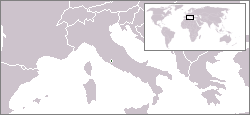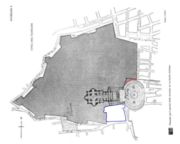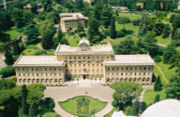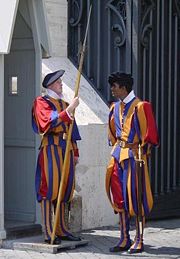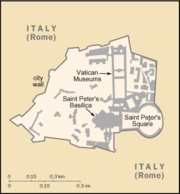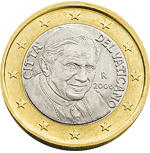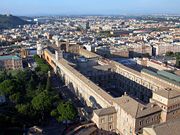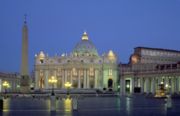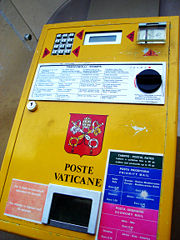Vatican City
2008/9 Schools Wikipedia Selection. Related subjects: Europe; European Countries
| Stato della Città del Vaticano (Italian) State of the Vatican City
|
||||||
|---|---|---|---|---|---|---|
|
||||||
| Anthem: " Inno e Marcia Pontificale" ( Italian) "Pontifical Anthem and March" |
||||||
|
|
||||||
| Capital | Vatican City1 |
|||||
| Official languages | Italian2 | |||||
| Government | Ecclesiastical | |||||
| - | Sovereign | Pope Benedict XVI | ||||
| - | President of the Governorate | Giovanni Lajolo | ||||
| Independence | from the Kingdom of Italy | |||||
| - | Lateran Treaty | 11 February 1929 | ||||
| Area | ||||||
| - | Total | 0.44 km² ( 234th) 0.17 sq mi |
||||
| Population | ||||||
| - | 2008 estimate | 824 ( 220th) | ||||
| - | Density | 1780/km² ( 6th) 4,610/sq mi |
||||
| Currency | Euro (€)3 ( EUR) |
|||||
| Time zone | CET ( UTC+1) | |||||
| - | Summer ( DST) | CEST ( UTC+2) | ||||
| Internet TLD | .va | |||||
| Calling code | +394 | |||||
| 1 | Vatican City is a city-state | |||||
| 2 | No official language is established by law, but, in accordance with paragraph 2 of the Legge sulle fonti del diritto of 7 June 1929, laws and regulations are published in the Italian-language Supplemento per le leggi e disposizioni dello Stato della Città del Vaticano attached to the Acta Apostolicae Sedis. The text of the first seven items published in that supplement is given here. Other languages are used by institutions situated within the state, such as the Holy See, the Pontifical Swiss Guard, the Pontifical Academy of Sciences, etc. See also Languages of the Vatican City. | |||||
| 3 | Prior to 2002, the Vatican lira (on par with the Italian lira). | |||||
| 4 | ITU-T assigns code 379 to Vatican City. However, Vatican City is included in the Italian telephone numbering plan and uses the Italian country code 39, followed by 06 (for Rome) and 698. | |||||
Vatican City, officially State of the Vatican City ( Italian: Stato della Città del Vaticano), is a landlocked sovereign city-state whose territory consists of a walled enclave within the city of Rome. At approximately 44 hectares (110 acres), and with a population of around 800, it is the smallest independent state in the world by both population and area.
Vatican City is a city-state. It came into existence only in 1929. It is thus clearly distinct from the central authority of the Roman Catholic Church, known as the Holy See, which existed long before 1929. Ordinances of Vatican City are published in Italian. Official documents of the Holy See are issued mainly in Latin. The two entities even have distinct passports: the Holy See, not being a country, only issues diplomatic and service passports; the state of Vatican City issues normal passports. In both cases the number of passports issued is extremely limited.
The Lateran Treaty in 1929, which brought the city-state into existence, spoke of it as a new creation (Preamble and Article III), not as a vestige of the much larger Papal States (756-1870) that had previously encompassed central Italy. Most of this territory was absorbed into the Kingdom of Italy in 1860, and the final portion, namely the city of Rome with a small area close to it, ten years later, in 1870.
Vatican City is a non-hereditary, elected monarchy that is ruled by the Bishop of Rome — the Pope. The highest state functionaries are all clergymen of the Catholic Church. It is the sovereign territory of the Holy See (Sancta Sedes) and the location of the Pope's residence, referred to as the Apostolic Palace.
The Popes have resided in the area that in 1929 became the Vatican City only since the return from Avignon in 1377. Previously, they resided in the Lateran Palace on the Caelian Hill on the opposite side of Rome, which was out of repair in 1377. The signing of the agreements that established the new state took place in the latter building, giving rise to the name of Lateran Pacts, by which they are known.
Territory
The name "Vatican" is ancient and predates Christianity, coming from the Latin Mons Vaticanus, meaning Vatican Mount. The territory of Vatican City is part of the Mons Vaticanus, and of the adjacent former Vatican Fields where St. Peter's Basilica, the Apostolic Palace, the Sistine Chapel, and museums were built, along with various other buildings. The area was part of the Roman rione of Borgo until 1929. Being separated from the city, on the west bank of the Tiber river, the area was an outcrop of the city that was protected by being included within the walls of Leo IV, and later expanded by the current fortification walls of Paul III/ Pius IV/ Urban VIII. When the Lateran Treaty of 1929 that gave the state its present form was being prepared, the boundaries of the proposed territory was influenced by the fact that much of it was all but enclosed by this loop. For some tracts of the frontier, there was no wall, but the line of certain buildings supplied part of the boundary, and for a small part of the frontier a modern wall was constructed. The territory includes St. Peter's Square, distinguished from the territory of Italy only by a white line along the limit of the square, where it touches Piazza Pio XII. St. Peter's Square is reached through the Via della Conciliazione which runs from the Tiber River to St. Peter's. This grand approach was constructed by Mussolini after the conclusion of the Lateran Treaty.
According to the Lateran Treaty, certain properties of the Holy See that are located in Italian territory, most notably Castel Gandolfo and the Patriarchal Basilicas, enjoy extraterritorial status similar to that of foreign embassies. These properties, scattered all over Rome and Italy, house essential offices and institutions necessary to the character and mission of the Holy See.
Castel Gandolfo and the named basilicas are patrolled internally by police agents of the Vatican City State and not by Italian police. St. Peter's Square is ordinarily policed jointly by both.
Head of state
The Pope is ex officio head of state and head of government of Vatican City, functions dependent on his primordial function as the bishop of the Archdiocese of Rome. The term Holy See refers not to the Vatican state but to the Pope's spiritual and pastoral governance, largely exercised through the Roman Curia. His official title with regard to Vatican City is Sovereign of the State of the Vatican City.
The papacy is a non-hereditary, elective monarchy, chosen by the College of Cardinals. The Pope is also technically an absolute monarch, meaning he has total legislative, executive and judicial power over Vatican City. He is the only absolute monarch in Europe. The Pope is elected for a life term in conclave by cardinals under the age of 80.
His principal subordinate government official for Vatican City is the President of the Pontifical Commission for Vatican City State, who since 1952 exercises the functions previously belonging to the Governor of Vatican City. Since 2001, the President of the Pontifical Commission for Vatican City State also has the title of President of the Governorate of the State of Vatican City.
The Pope resides in the Papal Apartments of the Papal Palace just off St. Peter's Square. It is here he carries out his business and meets foreign representatives.
The current Pope is Benedict XVI, born Joseph Alois Ratzinger in Bavaria, Germany. Italian Archbishop Giovanni Lajolo serves as President of the Pontifical Commission for the State of Vatican City. He was appointed by Pope Benedict XVI on 11 September 2006.
History
| Vatican City* | |
|---|---|
| UNESCO World Heritage Site | |
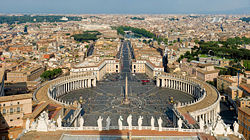 |
|
| State Party | |
| Type | Cultural |
| Criteria | i, ii, iv, vi |
| Reference | 286 |
| Region** | Europe |
| Inscription history | |
| Inscription | 1984 (8th Session) |
| * Name as inscribed on World Heritage List. ** Region as classified by UNESCO. |
|
Even before the arrival of Christianity, this originally uninhabited area on the opposite side of the Tiber from the city of Rome (the ager vaticanus) had long been considered sacred, or at least not available for habitation. Agrippina the Elder (14 BC – 18 October AD 33) drained the hill and environs and built her gardens there in the early 1st century AD. Emperor Caligula (37-41) started construction of a circus (40) that was later completed by Nero, the Circus Gaii et Neronis. The Vatican obelisk was originally taken by Caligula from Heliopolis to decorate the spina of his circus and is thus its last visible remnant. This area became the site of martyrdom of many Christians after the great fire of Rome in 64. Ancient tradition holds that it was in this circus that Saint Peter was crucified upside down. Opposite the circus was a cemetery separated by the Via Cornelia. Funeral monuments and mausoleums and small tombs as well as altars to pagan gods of all kinds of polytheistic religions were constructed lasting until before the construction of the Constantinian Basilica of St. Peter's in the first half of the 4th century. Remains of this ancient necropolis were brought to light sporadically during renovations by various popes throughout the centuries increasing in frequency during the Renaissance until it was systematically excavated by orders of Pope Pius XII from 1939 to 1941 .
In 326, the first church, the Constantinian basilica, was built over the site that Catholic apologists as well as noted Italian archaeologists argue was the tomb of Saint Peter, buried in a common cemetery on the spot. From then on the area started to become more populated, but mostly only by dwelling houses connected with the activity of St. Peter's. A palace was constructed near the site of the basilica as early as the 5th century during the pontificate of Pope Symmachus (pope 498-514).
Popes in their secular role gradually came to govern neighbouring regions and, through the Papal States, ruled a large portion of the Italian peninsula for more than a thousand years until the mid 19th century, when most of the territory of the Papal States was seized by the newly created Kingdom of Italy. For much of this time the Vatican was not the habitual residence of the Popes, but rather the Lateran Palace, and in recent centuries, the Quirinal Palace, while the residence from 1309-1377 was at Avignon in France.
In 1870, the Pope's holdings were left in an uncertain situation when Rome itself was annexed by the Piedmont-led forces which had united the rest of Italy, after a nominal resistance by the papal forces. Between 1861 and 1929 the status of the Pope was referred to as the " Roman Question". They were undisturbed in their palace, and given certain recognitions by the Law of Guarantees, including the right to send and receive ambassadors. But they did not recognize the Italian king's right to rule in Rome, and they refused to leave the Vatican compound until the dispute was resolved in 1929. Other states continued to maintain international recognition of the Holy See as a sovereign entity. In practice Italy made no attempt to interfere with the Holy See within the Vatican walls. However, they confiscated church property in many other places, including, perhaps most notably, the Quirinal Palace, formerly the pope's official residence. Pope Pius IX (1846-1878), the last ruler of the Papal States, claimed that after Rome was annexed he was a " Prisoner in the Vatican". This situation was resolved on February 11, 1929 between the Holy See and the Kingdom of Italy.
The treaty was signed by Benito Mussolini on behalf of King Victor Emmanuel III and by Cardinal Secretary of State Pietro Gasparri for Pope Pius XI. The Lateran Treaty and the Concordat established the independent State of the Vatican City and granted Catholicism special status in Italy. In 1984, a new concordat between the Holy See and Italy modified certain provisions of the earlier treaty, including the position of Catholicism as the Italian state religion.
Government
The politics of Vatican City takes place in an absolute elective monarchy, in which the head of the Catholic Church takes power. The Pope exercises ex officio principal legislative, executive, and judicial power over the State of Vatican City (an entity distinct from the Holy See), which is a rare case of a non-hereditary monarchy.
Political system
The government of Vatican City has a unique structure. The Pope is the sovereign of the state. Legislative authority is vested in the Pontifical Commission for Vatican City State, a body of cardinals appointed by the Pope for five-year periods. Executive power is in the hands of the President of that commission, assisted by the General Secretary and Deputy General Secretary. The state's foreign relations are entrusted to the Holy See's Secretariat of State and diplomatic service. Nevertheless, the pope has full and absolute executive, legislative and judicial power over Vatican City. He is currently the only absolute monarch in Europe.
There are specific departments that deal with health, security, telecommunications, etc.
The Cardinal Camerlengo heads the Apostolic Chamber to which is entrusted the administration of the property and the protection of the temporal rights of the Holy See during a sede vacante (papal vacancy). Those of the Vatican State remain under the control of the Pontifical Commission for the State of Vatican City. Acting with three other cardinals chosen by lot every three days, one from each order of cardinals (cardinal bishop, cardinal priest, and cardinal deacon), he in a sense performs during that period the functions of head of state. All the decisions these four cardinals take must be approved by the College of Cardinals as a whole.
The nobility that was closely associated with the Holy See at the time of the Papal States continued to be associated with the Papal Court after the loss of these territories, generally with merely nominal duties (see Papal Master of the Horse, Prefecture of the Pontifical Household, Hereditary officers of the Roman Curia, Black Nobility). They also formed the ceremonial Noble Guard. In the first decades of the existence of the Vatican City State, executive functions were entrusted to some of them, including that of Delegate for the State of Vatican City (now denominated President of the Commission for Vatican City). But with the motu proprio Pontificalis Domus of 28 March 1968, Pope Paul VI abolished the honorary positions that had continued to exist until then, such as Quartermaster General and Master of the Horse.
The State of the Vatican City, created in 1929 by the Lateran Pacts, provides the Holy See with a temporal jurisdiction and independence within a small territory. It is distinct from the Holy See. The state can thus be deemed a significant but not essential instrument of the Holy See. The Holy See itself has existed continuously as a juridical entity since Roman Imperial times and has been internationally recognized as a powerful and independent sovereign (at times even suzerain) entity since late antiquity to the present, without interruption even at times when it was deprived of territory (e.g. 1870 to 1929). The Holy See has the oldest active continuous diplomatic service in the world, dating back to at least AD 325 with its legation to the Council of Nicea. Ambassadors are accredited to the Holy See, never to the Vatican City State.
Administration
Legislative functions are delegated to the unicameral Pontifical Commission for Vatican City State, led by the President of the Pontifical Commission for Vatican City State. Its seven members are cardinals appointed by the Pope for terms of five years. Acts of the commission must be approved by the pope, through the Holy See's Secretariat of State, and before taking effect must be published in a special appendix of the Acta Apostolicae Sedis. Most of the content of this appendix consists of routine executive decrees, such as approval for a new set of postage stamps.
Executive authority is delegated to the Governorate of Vatican City. The Governorate consists of the President of the Pontifical Commission — using the title "President of the Governorate of Vatican City" — a General Secretary, and a Vice General Secretary, each appointed by the pope for five year terms. Important actions of the Governorate must be confirmed by the Pontifical Commission and by the Pope through the Secretariat of State.
The Governorate oversees the central governmental functions through several departments and offices. The directors and officials of these offices are appointed by the pope for five year terms. These organs concentrate on material questions concerning the state's territory, including local security, records, transportation, and finances. The Governorate oversees a modern security and police corps, the Corpo della Gendarmeria dello Stato della Città del Vaticano.
Judicial functions are delegated to a supreme court, an appeals court, a tribunal, and a trial judge.
In all cases, the pope may choose at any time to exercise supreme legislative, executive, or judicial functions in the state.
Military and police
Though earlier Popes recruited Swiss mercenaries as part of an army, the Pontifical Swiss Guard was founded by Pope Julius II on 22 January 1506 as the personal bodyguard of the Pope and continues to fulfil that function. It is listed in the Annuario Pontificio under "Holy See", not under "State of Vatican City". At the end of 2005, the Guard had 134 members. Recruitment is arranged by a special agreement between the Holy See and Switzerland, and is restricted to Catholic male (Swiss) citizens. The Palatine Guard and the Noble Guard were disbanded by Pope Paul VI in 1970. While the first body was founded as a militia at the service of the Papal States, its functions within the Vatican State, like those of the Noble Guard, were merely ceremonial.
The Corpo della Gendarmeria acts as a police force. Its full name is Corpo della Gendarmeria dello Stato della Città del Vaticano (which means " Gendarmerie Corps of the Vatican City State"), although it is sometimes referred to as Vigilanza, as a shortening of an earlier name. The Gendarmeria is responsible for public order, law enforcement, crowd and traffic control, and criminal investigations in Vatican City.
Foreign relations
Vatican City State is a recognized national territory under international law, but it is the Holy See that conducts diplomatic relations on its behalf, in addition to the Holy See's own diplomacy, entering into international agreements in its regard. The Vatican City State thus has no diplomatic service of its own. Foreign embassies to the Holy See are located in the city of Rome; only during the Second World War were the staffs of some embassies given what hospitality was possible within the narrow confines of Vatican City, embassies such as that of the United Kingdom while Rome was held by the Axis Powers, embassies such as Germany's when the Allies controlled Rome.
Given the distinction between the two entities, the Holy See's immense influence on world affairs is quite unrelated to the minuscule size of the Vatican City State.
Geography
The Vatican City, one of the European microstates, is situated on the Vatican Hill in the west-central part of Rome, several hundred metres west of the Tiber river. Its borders (3.2 kilometres (2.0 mi) in total, all within Italy) closely follow the city wall constructed to protect the Pope from outside attack. The situation is more complex at the famous St. Peter's Square in front of St. Peter's Basilica, where the correct border is just outside the ellipse formed by Bernini's colonnade, but where police jurisdiction has been entrusted to Italy. The Vatican City is the smallest sovereign state in the world at 0.44 square kilometres (44 ha/110 acres).
The Vatican climate is the same as Rome's; a temperate, Mediterranean climate with mild, rainy winters from September to mid-May and hot, dry summers from May to August. There are some local features, principally mists and dews, caused by the anomalous bulk of St Peter's Basilica, the elevation, the fountains and the size of the large paved square.
In July 2007, the Vatican agreed to become the first carbon neutral state. They plan to accomplish this by offsetting carbon dioxide emissions with the creation of a Vatican Climate Forest in Hungary.
Economy
The unique, non-commercial economy is supported financially by contributions (part of which is known as Peter's Pence) from Catholics throughout the world, the sale of postage stamps and tourist mementos, fees for admission to museums, and the sale of publications. The incomes and living standards of lay workers are comparable to, or somewhat better than, those of counterparts who work in the city of Rome.
The Vatican City issues its own coins. It has used the euro as its currency since January 1, 1999, owing to a special agreement with the EU (council decision 1999/98/CE). Euro coins and notes were introduced in January 1, 2002--the Vatican does not issue euro banknotes. Issuance of euro-denominated coins is strictly limited by treaty, though somewhat more than usual is allowed in a year in which there is a change in the papacy. Because of their rarity, Vatican euro coins are highly sought by collectors. Until the adoption of the Euro, Vatican coinage and stamps were denominated in their own Vatican lira currency, which was on par with the Italian lira.
It also has its own bank, Istituto per le Opere di Religione (also known as the Vatican Bank, and with the acronym IOR). This bank has an ATM with instructions in Latin, possibly the only such ATM in the world.
- Budget: Revenues (2003) 252 million USD; expenditures (2003) 264 million USD.
- Industries: printing and production of few mosaics and staff uniforms; worldwide financial activities.
Demographics
Population and languages
Almost all of Vatican City's 821 (July 2007 est.) citizens either live inside the Vatican's walls or serve in the Holy See's diplomatic service in embassies (called " nunciatures"; a papal ambassador is a "nuncio") around the world. The Vatican citizenry consists almost entirely of two groups: clergy, most of whom work in the service of the Holy See, and a very few as officials of the state; and the Swiss Guard. Most of the 3,000 lay workers who comprise the majority of the Vatican work force reside outside the Vatican and are citizens of Italy, while a few are citizens of other nations. As a result, all of the City's actual citizens are Catholic. Catholicism is the state religion. All the places of worship inside Vatican City are Catholic.
Vatican City has no set official language. Unlike the Holy See, which most often uses Latin for the authoritative version of official documents of the Catholic Church, Vatican City uses Italian in its legislation and official communications. Italian is also the everyday language used by most of those who work in the state. In the Swiss Guard, German is the language used for giving commands, but the individual guards take their oath of loyalty in their own languages, German, French or Italian. Vatican City's official website languages are Italian, English, French, German and Spanish.(This site should not be confused with that of the Holy See, which uses all these languages, along with Portuguese and, since 9 May 2008, also Latin.)
Citizenship
Citizenship of the Vatican City is granted iure officii, which means it is conferred upon some of those who have been appointed to work in certain capacities at the Vatican, and it is usually revoked upon the termination of their employment. During the period of employment citizenship may also be extended to a Vatican citizen's spouse (unless the marriage is annulled or dissolved, or if a conjugal separation is decreed) and children (until, if they are capable of working, they turn 25, or in the case of daughters, if they marry). Terms of citizenship are defined in the Lateran Treaty, and laws concerning the creation of the Vatican state in 1929 sought to restrict the number of people who could be granted Vatican citizenship. The only passports issued by the Vatican are diplomatic passports and service passports.
As of 31 December 2005, there were 558 people with Vatican citizenship, of whom 246 are dual-citizens of other countries (the majority being Italian). The Lateran Treaty provides that in the event a Vatican citizen has his or her original nationality revoked and also loses Vatican citizenship, he or she will be automatically granted Italian citizenship.
Among the 558 were:
- The Pope;
- 58 cardinals;
- 293 members of the clergy who serve as diplomatic envoys abroad;
- 62 lesser-ranking clergy members who work in the Vatican;
- 101 officers, NCOs, and men of the Papal Swiss Guard; and
- 43 lay persons.
Culture
The Vatican City is itself of great cultural significance. Buildings such as St. Peter's Basilica and the Sistine Chapel are home to some of the most famous art in the world, which includes works by artists such as Botticelli, Bernini, Raphael and Michelangelo. The Vatican Library and the collections of the Vatican Museums are of the highest historical, scientific and cultural importance. In 1984, the Vatican was added by UNESCO to the List of World Heritage Sites; it is the only one to consist of an entire state. Furthermore, it is the only site to date registered with the UNESCO as a centre containing monuments in the "International Register of Cultural Property under Special Protection" according to the 1954 Hague Convention for the Protection of Cultural Property in the Event of Armed Conflict.
Crime
Because, while the population is only a few hundred, millions visit the state each year, the crime rate measured against the resident population alone would seem enormous, as if 87.2% of the population committed civil offences each year, with penal offences running at a staggering 133.6% - 397 civil offences and 608 penal offences in 1992. The most common crime is petty theft - purse snatching, pickpocketing and shoplifting - and the perpetrators, being outsiders, like the victims, are rarely caught, with only 10% of crimes leading to a prosecution.
In accordance with Article 22 of the 1929 Lateran Treaty between the Holy See and Italy, the Italian government, when requested by the Holy See, handles the prosecution and detention of criminal suspects, at the expense of the Vatican. In 1969, the Vatican state abolished capital punishment, which was envisaged in the legislation it adopted in 1929 on the basis of Italian law, but which it never exercised.
Infrastructure
Transport
Vatican City has a reasonably well developed transport network considering its size. As a country that is 1.05 kilometres (0.6 mi) long and .85 kilometres (0.5 mi) wide, it has a small transportation system with no airports or highways. There is one heliport and a standard gauge railway connected to Italy's network at Rome's Saint Peter's station by an 852 metres (932 yd) long spur, only 14.35 metres (16 yd) of which is within Vatican territory. Pope John XXIII was the first Pope to make use of this railway, and Pope John Paul II used it as well, albeit very rarely. The railway is mainly used only to transport freight. As the Vatican City has no airports, it is served by the airports that serve the city of Rome, within which the Vatican is located, namely: Leonardo Da Vinci International Airport and to a lesser extent, Ciampino Airport, which both serve as the departure gateway for the Pope's international visits.
Communications
The City is served by an independent, modern telephone system, the Vatican Pharmacy, and post office. The postal system was founded on February 11, 1929, and two days later became operational. On August 1, the state started to release its own postal stamps, under the authority of the Philatelic and Numismatic Office of the Vatican City State. The City's postal service is sometimes recognised as "the best in the world" and mail has been noted to its target before the postal service in Rome. The Vatican also controls its own Internet domain, which is registered as ( .va). Broadband service is widely provided within Vatican City. Vatican City has also been given a radio ITU prefix, HV, and this is sometimes used by amateur radio operators.
Vatican Radio, which was organised by Guglielmo Marconi, broadcasts on short-wave, medium-wave and FM frequencies and on the Internet. Its main transmission antennae are located in Italian territory. Television services are provided through another entity, the Vatican Television Centre.
L'Osservatore Romano is the multilingual semi-official newspaper of the Holy See. It is published by a private corporation under the direction of Catholic laymen but reports on official information. However, the official texts of documents are in the Acta Apostolicae Sedis, the official gazette of the Holy See, which has an appendix for documents of the Vatican City State.
Vatican Radio, the Vatican Television Centre, and L'Osservatore Romano are organs not of the Vatican State but of the Holy See, and are listed as such in the Annuario Pontificio, which places them in the section "Institutions linked with the Holy See", ahead of the sections on the Holy See's diplomatic service abroad and the Diplomatic Corps accredited to the Holy See, after which is placed the section on the State of Vatican City.


